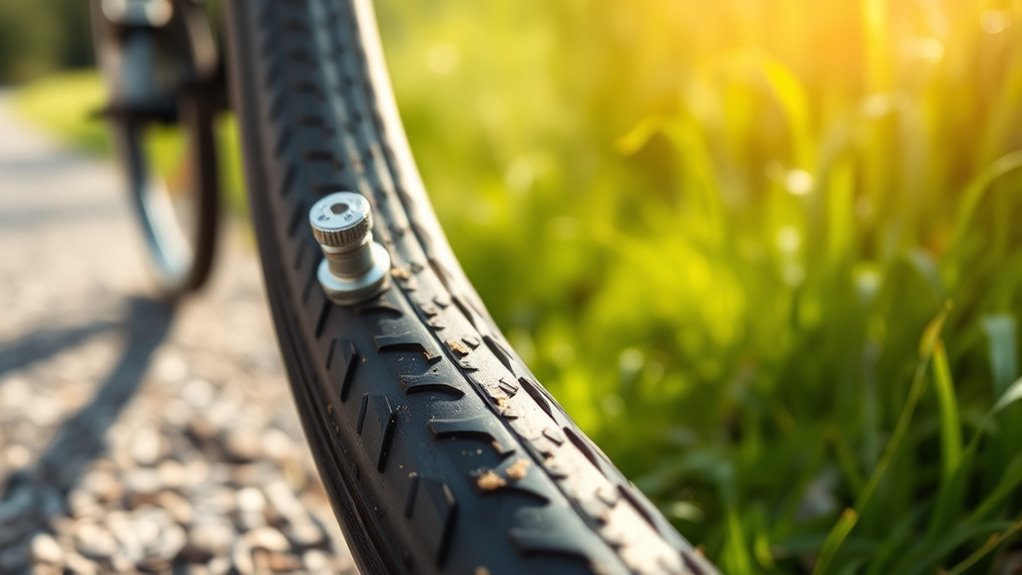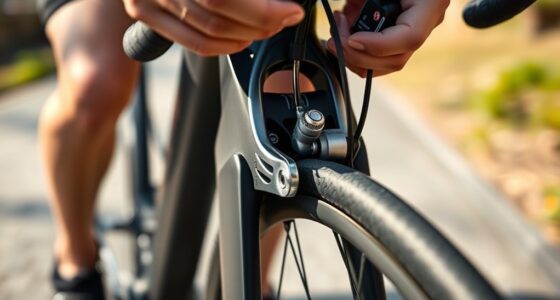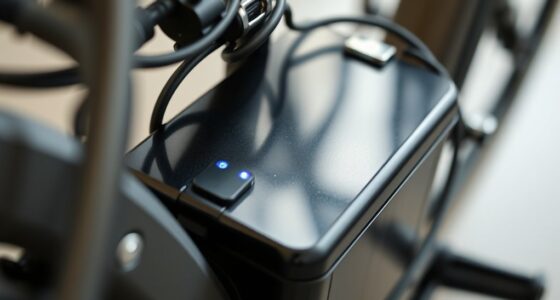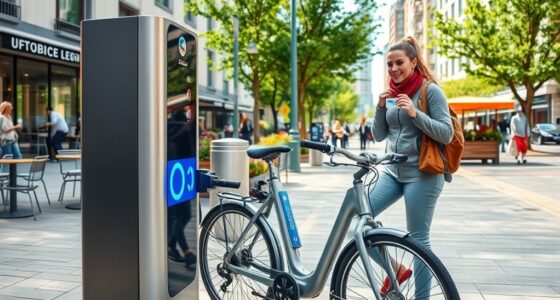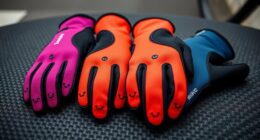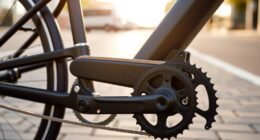Maintaining proper tire pressure on your e-bike is key to safe, efficient riding. When your tires are well-inflated, you get better control, smoother rides, and longer tire life. Too low or too high pressure can cause uneven wear, punctures, or harsh handling, risking safety. It also helps conserve battery power by reducing rolling resistance. To maximize performance and safety, you should regularly check and adjust your tire pressure — and there’s more to learn from here.
Key Takeaways
- Proper tire pressure enhances e-bike handling, safety, and ride comfort across various terrains.
- Correct inflation reduces rolling resistance, improving battery efficiency and extending ride distance.
- Maintaining optimal pressure prevents uneven tire wear, flats, and reduces the risk of accidents.
- Adjusting tire pressure based on rider weight and terrain optimizes performance and control.
- Regularly checking tire pressure ensures safety, longevity, and consistent e-bike performance.
How Proper Tire Inflation Enhances Riding Performance
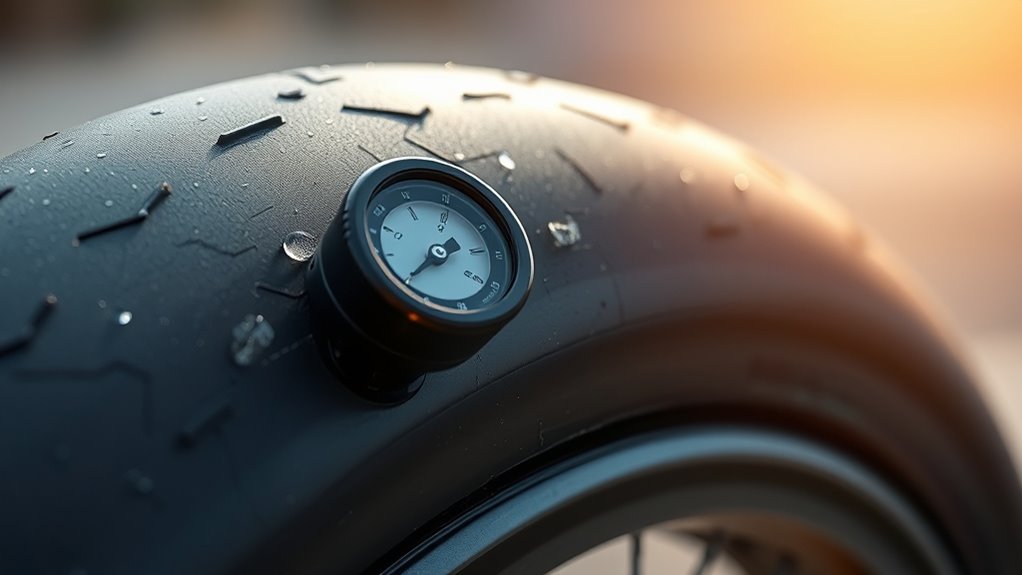
Proper tire inflation is crucial because it directly affects how well your e-bike performs. When you calibrate your tire pressure correctly, you guarantee ideal contact with the road, which improves handling and efficiency. Using inflation tools like a quality pressure gauge or pump makes it easy to maintain the right tire pressure. Properly inflated tires reduce rolling resistance and make pedaling smoother, allowing you to ride longer distances with less effort. It also helps prevent flats caused by under-inflation and minimizes tire wear from over-inflation. Regularly checking and adjusting tire pressure ensures your e-bike responds as intended, giving you a safer, more comfortable ride. Keeping your tires properly inflated is a simple yet essential step to maximize your e-bike’s performance. Additionally, monitoring air quality when riding can enhance your overall experience and safety.
The Impact of Tire Pressure on Safety and Stability
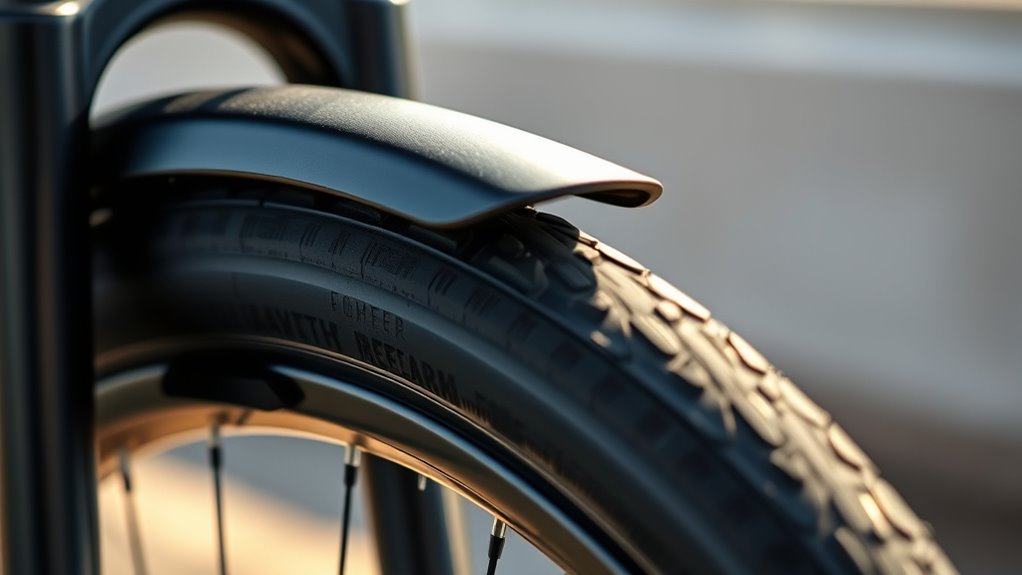
Maintaining the right tire pressure is vital for your safety and bike stability. Underinflated tires can cause poor control and increase the risk of accidents, while overinflated ones may make handling feel harsh and unpredictable. Finding the best pressure helps you stay balanced and reduces handling issues on different terrains. Proper tire pressure is also essential for optimal performance tuning of your vehicle, ensuring that all components work harmoniously for a safe ride.
Optimal Pressure for Control
Have you ever wondered how tire pressure directly affects your control and safety while riding an e-bike? Proper tire pressure guarantees the best grip and handling, making your ride safer and more predictable. To achieve this, use reliable tire pressure gauges to measure your tires accurately. Modern inflation technology, such as digital pumps with built-in gauges, simplifies maintaining the right pressure. When tires are inflated to the recommended range—often indicated on the sidewall—you maximize stability and control, especially on turns or uneven terrain. Overinflated tires can reduce grip, while underinflation leads to sluggish handling. Regularly checking and adjusting your tire pressure with precise tools ensures your e-bike performs at its best, giving you confidence on every ride. Additionally, understanding bedroom decor principles can help create a comfortable space for relaxation after riding.
Risks of Underinflation
Underinflated tires can considerably compromise your safety and stability on an e-bike. When tires aren’t properly inflated, you’re more likely to experience uneven tire wear, which weakens the tire structure over time. This increases the risk of sudden punctures, leaving you stranded or causing a dangerous loss of control. Underinflation also reduces your bike’s grip on the road, especially on wet or uneven surfaces, making it harder to steer and increasing the chance of accidents. Additionally, underinflated tires generate more heat during rides, further weakening the rubber and accelerating tire wear. To stay safe and extend your tire’s lifespan, always maintain the recommended pressure and check it regularly before rides. Proper inflation is essential for safety, stability, and ideal performance.
Overinflation and Handling
When tires are overinflated, your e-bike’s handling can become unpredictable and less responsive. You might notice a harsher ride, making steering feel stiff and less precise. Overinflation causes uneven tire contact with the road, increasing tire wear and the risk of punctures. Stability diminishes, especially on uneven surfaces, raising safety concerns. Use this table to understand the effects:
| Effect | Cause | Result |
|---|---|---|
| Reduced grip | Overinflation reduces tire contact | Less control, higher accident risk |
| Uneven tire wear | Excess pressure wears center more | Shorter tire lifespan |
| Increased puncture risk | Stiffened tires resist impact | Higher chance of flats |
Keeping your tires at proper pressure balances handling, tire longevity, and safety. Proper inflation also ensures your headphones connect correctly and function optimally, highlighting the importance of well-maintained equipment.
How Under-Inflated and Over-Inflated Tires Affect Your E-Bike

Proper tire pressure is essential for your e-bike’s performance and safety. When your tires are under-inflated, you’ll notice increased tire wear on the edges and a rougher ride. It also makes steering less responsive and can cause pinch flats. Over-inflated tires, on the other hand, reduce traction and lead to a harsher ride, risking blowouts. Using reliable inflation tools helps you maintain the correct pressure and avoid these issues. Over time, inconsistent pressure damages tires faster and can compromise your bike’s handling. Regularly checking and adjusting your tire pressure guarantees ideal performance, safety, and longevity. Avoid guessing or relying on visual cues—accurate inflation tools are your best ally for maintaining balanced, safe tires. Ensuring optimal tire pressure can also extend the lifespan of your tires, saving you money in the long run Comfort and Support Solutions.
The Relationship Between Tire Pressure and Battery Efficiency
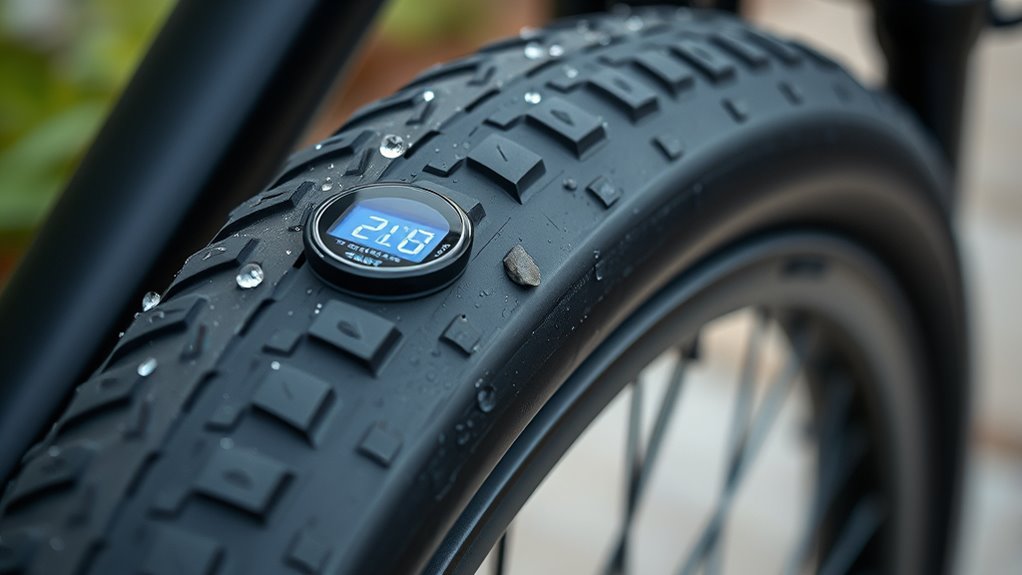
Maintaining the correct tire pressure on your e-bike directly impacts your battery’s efficiency. When tires are properly inflated, the tire tread contacts the ground ideally, reducing rolling resistance and conserving battery power. Conversely, under- or over-inflation causes uneven wear and affects rubber composition, making tires less responsive and increasing energy consumption. Proper pressure ensures the tire’s rubber maintains its intended flexibility and durability, which supports better traction and smoother rides. Additionally, smart features in some tires can help monitor pressure levels and alert you when adjustments are needed.
Tips for Checking and Maintaining Optimal Tire Pressure

Regularly checking your e-bike’s tire pressure is essential to guarantee peak performance and safety. Start by inspecting your tires’ recommended PSI, usually printed on the sidewall, which varies based on tire material. Use reliable inflation tools, like a digital or analog pressure gauge, to get accurate readings. When adding air, ensure your pump matches your tire material—some tires, like tubeless or high-pressure models, require specific inflation techniques. Check the pressure when tires are cold, ideally before riding, to get an accurate measurement. Maintain proper pressure by adjusting regularly, especially after long rides or changes in temperature. Properly inflated tires reduce wear, improve efficiency, and prevent flats, giving you a safer, smoother ride every time. Additionally, portable camping gear such as portable air pumps can make tire maintenance more convenient during outdoor trips.
Common Signs That Your E-Bike Tires Need Adjustment
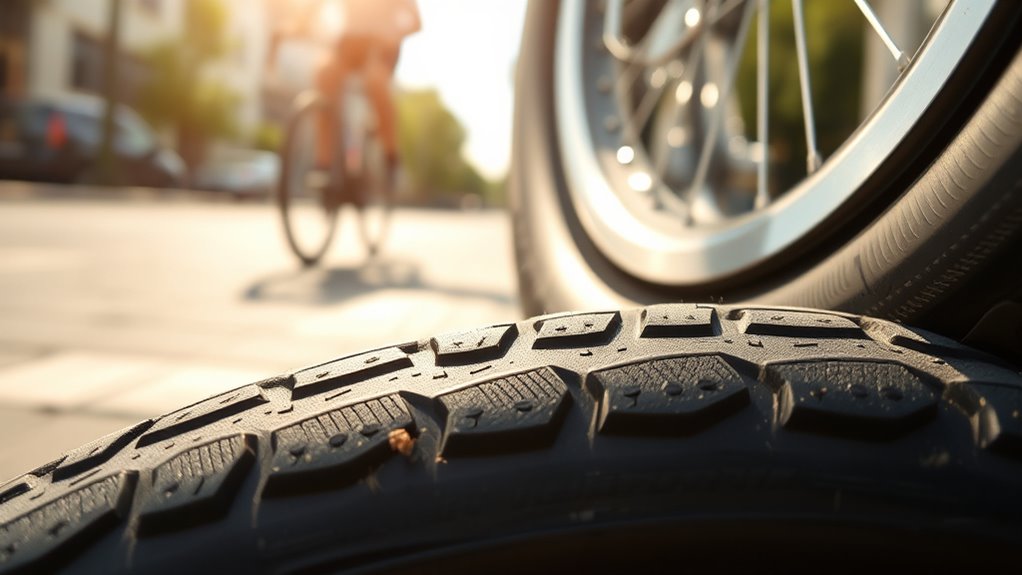
If your e-bike tires aren’t performing as they should, certain signs can alert you that they need adjustment. You might notice uneven tire wear, which indicates misaligned or improperly inflated tires. Another sign is increased puncture risk, often caused by under-inflated tires that are more susceptible to sharp objects. Additionally, if you feel a loss of control or a rough ride, it’s a clear signal that your tire pressure isn’t *ideal*. Keep an eye out for these indicators, as ignoring them can lead to further damage or safety issues. Regularly checking for uneven tire wear, listening for unusual sounds, and noting changes in ride comfort can help you identify when adjustment is necessary. Proper tire pressure is key to safety and longevity. Embracing creativity in the digital age can also inspire you to explore innovative ways to maintain and optimize your e-bike’s performance.
Best Practices for Adjusting Tire Pressure for Different Riding Conditions
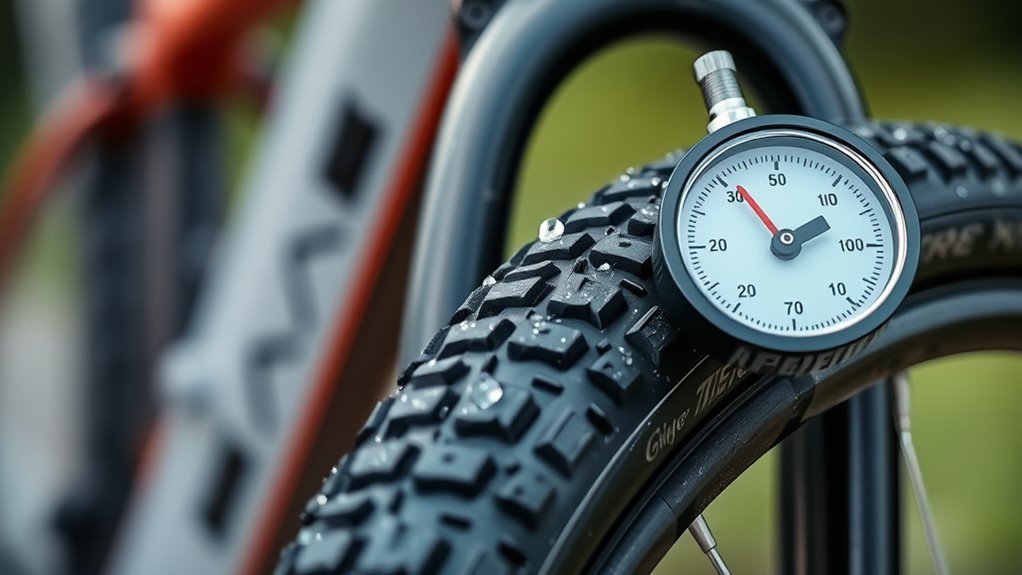
To get the best ride, you need to adjust your tire pressure based on the terrain, speed, and your weight. Softer tires work better on rough surfaces, while firmer tires boost speed on smooth roads. Keep these factors in mind to find the perfect balance for every ride. Proper tuning of your bike’s settings can also enhance performance and safety.
Adjust for Terrain Type
Adjusting your e-bike tire pressure based on terrain can considerably improve your riding experience and safety. When tackling different surfaces, consider how tire tread and rim compatibility influence your setup. For rough, uneven terrain, lower pressure allows the tire to absorb shocks better, providing more grip and comfort. Conversely, higher pressure on smooth pavements reduces rolling resistance and enhances efficiency. Always guarantee your rim can handle the adjusted pressure without risking damage or rim failure. Pay attention to tire tread patterns; knobby tires perform best at lower pressures on loose surfaces, while slicker tires are suited for higher pressures on asphalt. Properly adjusting pressure for terrain not only maximizes performance but also prolongs tire lifespan and enhances overall riding safety. Additionally, understanding the contrast ratio of your tires and rims can help optimize performance in various conditions.
Optimize for Speed & Comfort
Optimizing your e-bike’s tire pressure for speed and comfort requires understanding how different pressures impact ride quality. Higher pressures reduce rolling resistance, helping you go faster on smooth surfaces, while lower pressures increase comfort by absorbing bumps. Keep an eye on your tire tread; a well-maintained tread ensures maximum grip and reduces the risk of punctures. Proper pressure also enhances puncture prevention by minimizing pinch flats that occur when tires are too soft or too hard. Adjusting pressure based on your riding conditions allows you to balance speed and comfort effectively. Remember, over-inflated tires may feel harsh and decrease traction, while under-inflated tires can lead to sluggish performance. Finding the right balance ensures a smoother, safer ride tailored to your needs. Regularly checking your tire pressure and using the proper tools can help maintain optimal performance.
Consider Rider Weight
Your rider weight plays a significant role in determining the ideal tire pressure for a comfortable and efficient ride. Heavier riders will cause more tire deformation, so increasing the pressure helps maintain shape and performance. Conversely, lighter riders can often run slightly lower pressures for better traction and comfort without risking pinch flats. To fine-tune your setup:
- Adjust pressure based on rider weight to minimize excessive tire deformation
- Consider the impact of tire deformation on rolling resistance and handling
- Use a pressure gauge to make sure accurate inflation tailored to your weight and riding conditions
- Remember that tire deformation can influence not only comfort but also the durability of your tires and your overall safety.
Frequently Asked Questions
How Often Should I Check My E-Bike Tire Pressure?
You should check your e-bike tire pressure regularly to guarantee safety and ideal performance. It’s recommended to do tire pressure monitoring at least once every two weeks, especially before long rides. Incorporate this into your maintenance schedule to prevent flats and improve efficiency. Always use a reliable gauge and adjust the pressure according to your bike’s specifications. Regular checks keep your ride smooth and extend your tires’ lifespan.
What Is the Ideal Tire Pressure for Different Terrains?
When considering ideal tire pressure for different terrains, you should make terrain-specific adjustments to optimize your ride. For smooth pavement, keep your pressure higher for efficiency and speed. On rough or off-road surfaces, lower the pressure to increase grip and absorb shocks. Always check your tire pressure regularly and adjust accordingly, ensuring you’re using the right pressure for each terrain to improve safety, comfort, and performance.
Can Changing Tire Pressure Improve Battery Life?
Adjusting your tire pressure can indeed improve battery efficiency. When you optimize your tire pressure, it reduces rolling resistance, making it easier for your e-bike to move. Proper Tire pressure optimization helps your motor work less, conserving energy and extending your battery life. By maintaining the right pressure for your terrain, you’ll enjoy a smoother ride while maximizing your e-bike’s battery performance.
How Does Temperature Affect E-Bike Tire Pressure?
Imagine your tires as tiny balloons, stretching and contracting with temperature swings. Temperature effects cause tire pressure fluctuations, often silently shifting with the seasons or weather changes. When it’s cold, air contracts, lowering pressure; when it’s hot, air expands, increasing it. These temperature effects mean you should check your tire pressure regularly, especially during weather changes, to guarantee ideal ride quality and safety.
Are There Recommended Pressure Ranges for Different Rider Weights?
Your rider weight definitely influences the recommended tire pressure. Lighter riders should use slightly lower pressure, around 40-50 psi, for a smooth ride, while heavier riders might need 60-70 psi to prevent flats and maintain control. Always check your bike’s manufacturer guidelines and adjust the tire pressure based on your weight to guarantee maximum performance and safety. Proper pressure helps you ride comfortably and efficiently.
Conclusion
So, next time your e-bike feels like a wild stallion or a sluggish snail, remember—tire pressure isn’t just a boring detail, it’s the secret sauce to riding bliss. Ignore it, and you might as well be pedaling on marshmallows. Keep those tires inflated right, and you’ll enjoy smoother rides, better battery life, and fewer surprises. Because nothing says “smart rider” like knowing your tires aren’t crying for help. Happy pedaling!
